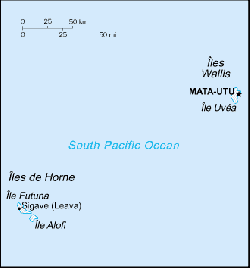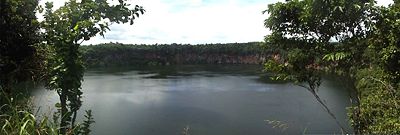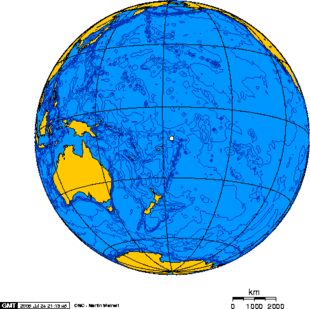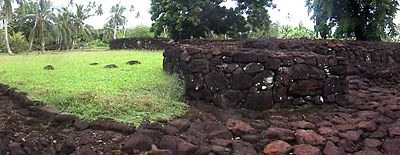Wallis and Futuna
| Territoire des √ģles Wallis et Futuna/ Telituale o Uvea mo Futuna Territory of the Wallis and Futuna Islands |
||||||
|---|---|---|---|---|---|---|
|
||||||
| Motto:¬†Libert√©, √Čgalit√©, Fraternit√© | ||||||
| Anthem: La Marseillaise |
||||||
| Capital (and largest city) | Mata-Utu 13¬į17‚Ä≤S 176¬į11‚Ä≤W | |||||
| Official languages | French | |||||
| Vernacular languages | ĽUvean, Futunan | |||||
| Ethnic groups  | Polynesian[1] | |||||
| Demonym | Wallisian, Futunan | |||||
| Government | Dependent territory | |||||
|  -  | President of France | Nicolas Sarkozy | ||||
|  -  | Administrator Superior | Michel Jeanjean | ||||
|  -  | President of the Territorial Assembly | Victor Brial | ||||
|  -  | Kings (traditionally three) |
Kapiliele Faupala King of Uvea since 2008,[2] vacant, King of Alo since 22 January 2010 Polikalepo Kolivai, King of Sigave since 2010 |
||||
| Overseas collectivity of France | ||||||
|  -  | Overseas territory | 1959 (voted to be a territory of France)  | ||||
|  -  | Overseas collectivity | 2003  | ||||
| Area | ||||||
|  -  | Total | 264 km² (211th) 102 sq mi  |
||||
|  -  | Water (%) | negligible | ||||
| Population | ||||||
|  -  | July 2009 estimate | 15,289[1] (220th) | ||||
|  -  | July 2008 census | 13,484[3]  | ||||
|  -  | Density | 57.9/km² (125th) 149.9/sq mi |
||||
| GDP (nominal) | 2005 estimate | |||||
|  -  | Total | US$188 million[4] (not ranked) | ||||
|  -  | Per capita | US$12,640[4] (not ranked) | ||||
| Currency | CFP franc (XPF) |
|||||
| Time zone | (UTC+12) | |||||
| Internet TLD | .wf | |||||
| Calling code | ++681 | |||||
Wallis and Futuna, is a group of three volcanic tropical islands‚ÄĒWallis Island (Uvea), Futuna Island, and Alofi Island‚ÄĒwith fringing reefs located in the South Pacific Ocean between Fiji and Samoa, and about two-thirds of the way from Hawaii to New Zealand. The islands are approximately 125 miles (200 kilometers) apart. The small, remote territory of Wallis and Futuna is an example of a relatively undisturbed blend of Christianity and Polynesian culture.
Geography
The Wallis Archipelago is the most populated of the island group and comprises a main island and about 20 smaller islands and islets. The main island, Wallis (Uvea), is hilly and dotted with numerous lake-filled craters surrounded by steep cliffs. The Futuna Archipelago consists of two mountainous islands, Futuna (Hooru) and Alofi. On Futuna the land rises steeply from a narrow coastal plain to a highest point of 2870 feet (875 meters). There are no permanent settlements on Alofi because of the lack of natural fresh water. The cannibal people of Futuna allegedly killed and feasted upon the population of Alofi in a single raid in the nineteenth century. The total area is 106 square miles (274 square kilometers) with 80 miles (129 kilometers) of coastline.
The highest point in the territory is Mont Singavi (on the island of Futuna) at 2510 feet (765 meters).
The climate is tropical, but moderated by ocean breezes. The islands have a hot, rainy season from November to April and a cool, dry season from May to October. The rains accumulate 98 to 118 inches (2500 to 3000 millimeters) each year. The average humidity is 80 percent and the average temperature is 79.9 degrees Fahrenheit (26.6 degrees Celsius).
The only indigenous animals are snakes, lizards, and pigeons. Coconut palms and breadfruit, mango, and orange trees are grown on the coasts, and the hills are densely forested.
Only five percent of the islands' land area is arable land; permanent crops cover another 20 percent. Deforestation (only small portions of the original forests remain) is a serious problem, and is largely a result of the continued use of wood as the main fuel source. Deforestation also means the mountainous terrain of Futuna is particularly prone to erosion.
The capital of the territory is Mata-Utu on the island of Wallis.
History
Archaeological excavations in Wallis have uncovered sites dating back to 1400 B.C.E. The Tongans arrived in the fifteenth century and took possession of the island after battles that have become legendary. Wallis emerged from the Early Tongan Maritime Empire in the 1500s. Before that time it was part of Tonga and shared its language and customs. Futuna has close cultural ties with Samoa and Rotuma.
Futuna and Alofi were sighted by two Dutch navigators, Jakob Lemaire and Willem Cornelis Schouten, in 1616. British explorer Samuel Wallis visited Wallis in 1767. The French were the first Europeans to settle in the territory, when missionaries arrived in 1837, and converted the population to Catholicism. Those first Marist missionaries were Father Bataillon, on Wallis island, and Father Chanel on Futuna island. With the arrival of the Catholic mission, a long history of warfare on the islands ended.
On April 5, 1842, the missionaries asked France for protection after part of the local population rebelled. Around this time, the French banned overseas voyaging, so ties between Wallis and Tonga weakened. On April 5, 1887, the queen of Uvea (on the island of Wallis) signed a treaty establishing a French protectorate. The kings of Sigave and Alo on the islands of Futuna and Alofi also signed a treaty establishing a French protectorate on February 16, 1888. The islands were put under the authority of the French Colony of New Caledonia. In 1917, the three traditional chiefdoms were annexed to France and turned into the Colony of Wallis and Futuna, still under the authority of the Colony of New Caledonia.
Politics
Wallis and Futuna has been a French overseas collectivity since 2003. Between 1961 and 2003, it had the status of an overseas territory.
The territory is divided into three traditional chiefdoms: Uvea (on the island of Wallis), Sigave (on the western part of the island of Futuna), and Alo (on the island of Alofi and on the eastern part of the island of Futuna). Uvea is further subdivided into three districts: Hanake, Hihifo, and Mua. As a territory of France, Wallis and Futuna is governed under the French constitution, uses the French legal system, and suffrage is universal for those over 18 years of age. The French president is elected by popular vote for a five-year term. The high administrator is appointed by the French president on the advice of the French Ministry of the Interior. Members of the assembly elect the presidents of the Territorial Government and the Territorial Assembly.
The head of state was President Jacques Chirac of France as represented by High Administrator Xavier de Furst since 2005. The head of government was the President of the Territorial Assembly, Patalione Kanimoa, since 2001. The Council of the Territory consists of the three kings of the three traditional chiefdoms, and three members appointed by the high administrator on the advice of the Territorial Assembly.
The legislative branch consists of the unicameral Territorial Assembly of 20 seats. The members are elected by popular vote to serve five-year terms. Wallis and Futuna elects one senator to the French Senate and one deputy to the French National Assembly.
Justice is administered under French law by a tribunal in Mata-Utu, but the three traditional chiefdoms administer justice according to customary law for non-criminal cases. The court of appeal is in Nouméa, New Caledonia.
The territory participates in the CFP franc zone and Secretariat of the Pacific Community.
Economy
Copra was an important export until the mid-1960s, when an attack of rhinoceros beetles ravaged the islands' palm trees. Some copra and timber is exported. Many islanders have migrated to New Caledonia for employment.
The territory's economy is limited to traditional subsistence agriculture, with about 80 percent of the labor force earning its livelihood from agriculture (coconuts and vegetables), livestock (mostly pigs), and fishing. About four percent of the population is employed in government. Revenues come from French Government subsidies, licensing of fishing rights to Japan and South Korea, import taxes, and remittances from expatriate workers in New Caledonia. The gross domestic product in 2004 totaled about $US 60 million, or about $US 3,800 per capita. Industries include copra, handicrafts, fishing, and lumber. Agricultural products include breadfruit, yams, taro, bananas, pigs, and goats.
In 1999, exports totaled $US 47,450. Export commodities were copra, chemicals, and construction materials. Export partners were Italy (40 percent), Croatia (15 percent), the United States (14 percent), and Denmark (13 percent). Imports totaled $US61.17 million. Import commodities were chemicals, machinery, passenger ships, and consumer goods. Import partners were France (97 percent), Australia (two percent), and New Zealand (one percent).
In 2002, the territory had 1900 telephones in use, one AM radio station, and two television broadcast stations.
The island of Wallis has about 62 miles (100km) of highway, ten miles (16 km) of it paved, while the island of Futuna has only about 12 miles (20km), none of it paved. The territory has two main ports and harbors, Leava (on the island of Futuna), and Mata-Utu, that support its two passenger ships and one petroleum tanker. There are two airports, one with a paved runway about 6560 feet (2000 meters) long, one with a 3280 foot (1000-meter) unpaved strip. The only commercial flights to Wallis are operated by the New Caledonia-based Aircalin. There is an Aircalin office in Mata-Utu on Wallis. There are no commercial boat operators.
The territory uses the CFP Franc, along with the French territories of New Caledonia and French Polynesia.
Demographics
The total population of the territory at the 2003 census was 14,944 (67.4 percent on the island of Wallis, 32.6 percent on the island of Futuna).
The vast majority are of Polynesian ethnicity, with a small minority of French descent. More than 16,000 Wallisians and Futunans live as expatriates in New Caledonia, which is more than the total population of Wallis and Futuna.
The overwhelming majority (99 percent) of the people in Wallis and Futuna are Catholic.
They speak both French and Wallisian (58.9 percent) or Futunan (30.1 percent), the indigenous Polynesian languages. The Uvean language of Wallis is a Western Polynesian language closely related to Tongan. The Futunan language is of Samoic origin. It is the language of everyday life. French is only spoken by 10.8 percent of the population as a first language, though it is used on official occasions and is taught in schools. A few people also speak English.
Class stratification is perhaps more pronounced on Futuna. In Wallis, the traditional hierarchy persists, with the Lavelua at the apex and most people referred to as commoners. A distinction exists between families with and without cash income. Remittances from family members overseas also distinguish families. The Catholic Church is the largest landowner. Families that have produced a priest or nun have a high status. Symbols of difference include owning a car or truck, a large house, furniture, having access to electricity, and knowledge of life in New Caledonia. Gifts to the church are important indicators of status.
Education levels are not important markers of social class, and only half the total population (both men and women) age 15 and over can read and write. Each village has a primary school. New Caledonia has been the sole source of tertiary education until a two-year post-secondary program opened on the islands in l990.
Culture
The culture of Wallis and Futuna is typically Polynesian, with strong emphasis on marriage and extended families centered on the church. Marriages are controlled by the family and formalized by the church, according to sociologist Nancy J. Pollock. Missionaries once raised young boys and girls apart from their families and then arranged their marriages. Today young people meet in high school, and families approve or disapprove of the friendship. Cohabitation occurs but is not approved of. Aunts and grandmothers raise illegitimate children.
An extended family household is the basic unit of society in Wallis and Futuna, and is likely to consist of several houses linked by brothers and sisters and their spouses, Pollock writes. Households change in size as young people and their children go to New Caledonia, leaving one or two children to look after the parents. When a young couple marries, they join the household of one of their families. It is rare for a new house to be built. The father, the eldest son, and occasionally, the eldest sister is head of the household. Close ties are maintained between members of the extended family, despite separation over distance. Both sons and daughters inherit rights to the land, and membership in the kinship group. One son and one daughter are expected to look after the parents, and the siblings of their parents.
Wallis is predominantly a rural community. All villages are linked by road to Mata-Utu and are built around a Catholic church where people gather at large family occasions. A program to teach building skills has led to the construction of numerous churches built with expensive imported materials. Houses are built mainly of concrete with corrugated iron roofs, although a few houses with pandanus-thatch sides and thatched roofs still exist. People prefer to sit on the floor. Some cooking is done outdoors. Newer houses have toilets attached. Houses are scattered and have one or two acres of land to grow subsistence crops. A house site may consist of four or five houses for the extended family.
Futunan houses follow the Samoan ‚Äúfale‚ÄĚ style, according to Pollock. The sleeping house is open-sided with a thatched roof and thatched blinds that can be let down in bad weather. There may be a concrete floor and a low wall to keep the pigs out. Cooking is done in a cook-house behind the sleeping house or in an earth oven in the bush. Water and electricity were installed in 1990, though few families can afford electricity.
There is ‚Äúbush land‚ÄĚ and ‚Äúhouse land.‚ÄĚ Families ‚Äúpossess" lands that link them to a ‚Äúpule‚ÄĚ and ultimately to the traditional chief. There is also land for use by members of the village. Family land rights are passed to both sons and daughters, but males are responsible for keeping the land productive. All family members are expected to work on the family land.
Wallis has an urban area that contains government buildings and shopping. Futuna consists of a string of villages along the southern coast, of which Leava is the main center. Each village has a small shop.
The kava bowl and tapa cloth are important symbols of both cultures. Kava is drunk both ritually and secularly in Futuna. The kava bowl is used to honor chiefs and the existing hierarchy. Tapa cloth is made by women from the bark of the breadfruit tree for exchange at rituals that draw extended families together. The cloth, along with specially scented oil, symbolizes women's wealth. Tapa is also sold to tourists.
Food gifts are symbols of welcome and good will, Pollock notes. The "malae," or meeting ground, is a place where people gather to honor their chiefs (kings in Futuna). The Lomipeau canoe, a large traditional boat that could hold up to 100 people, represents the ties between Wallis-Uvea and the early maritime empire of Tonga of four hundred years ago. It also symbolizes the strong seagoing tradition of these people, particularly their journeys to Tonga, Samoa, and other islands.
The music of Wallis and Futuna has a rich tradition, and is overwhelmingly Polynesian in form. Traditional music is taught by specialists called ‚Äúm√Ęau.‚ÄĚ Prominent composers include Helena Puino, Apeleto Likuvalu, and Likaleto Simete. The Association Culturelle de Futuna promotes indigenous music. In 1999, Roland Di Rosa, a sound engineer, released Digital Studio, a compilation of Wallisian music. He has continued to release compilations that include performers like Ofamahi, Taulaga, and Semata.
The Kailao, often thought of as a Tongan war dance, was taken to Tonga from Uvea.
Notes
- ‚ÜĎ 1.0 1.1 Central Intelligence Agency, Wallis and Futuna The World Factbook.
- ‚ÜĎ "Kapeliele Faupala crowned new king of Wallis", Radio New Zealand, 25 July 2008. Retrieved January 21, 2012.
- ‚ÜĎ INSEE. Les populations des circonscriptions du Territoire des √ģles Wallis et Futuna. Government of France. Retrieved January 21, 2012. (French)
- ‚ÜĎ 4.0 4.1 (French) Olivier Simon, L‚Äô√©conomie de Wallis-et-Futuna en 2005: Une √©conomie traditionnelle et administr√©e INSEE, CEROM (Avril 2008).Retrieved January 21, 2012.
ReferencesISBN links support NWE through referral fees
All Reference Links Retrieved April 6, 2008.
- Open Directory Project - Wallis and Futuna directory category
- World Statesmen - Wallis and Futuna politics and government
- Map of Wallis and Futuna
- Map of Wallis and Futuna, with district boundaries
- Information about Wallis and Futuna
- Pictures of Wallis
- Statistics of Wallis and Futuna
| Countries and territories of Oceania | |
| Australia : Australia · Norfolk Island | |
| Melanesia : East Timor · Fiji · Maluku Islands & Western New Guinea (part of Indonesia) · New Caledonia · Papua New Guinea · Solomon Islands · Vanuatu | |
| Micronesia : Guam · Kiribati · Marshall Islands · Northern Mariana Islands · Federated States of Micronesia · Nauru · Palau · Wake Island | |
| Polynesia : American Samoa · Cook Islands · French Polynesia · Hawaii · New Zealand · Niue · Pitcairn Islands · Samoa · Tokelau · Tonga · Tuvalu · Wallis and Futuna | |
Credits
New World Encyclopedia writers and editors rewrote and completed the Wikipedia article in accordance with New World Encyclopedia standards. This article abides by terms of the Creative Commons CC-by-sa 3.0 License (CC-by-sa), which may be used and disseminated with proper attribution. Credit is due under the terms of this license that can reference both the New World Encyclopedia contributors and the selfless volunteer contributors of the Wikimedia Foundation. To cite this article click here for a list of acceptable citing formats.The history of earlier contributions by wikipedians is accessible to researchers here:
The history of this article since it was imported to New World Encyclopedia:
Note: Some restrictions may apply to use of individual images which are separately licensed.





